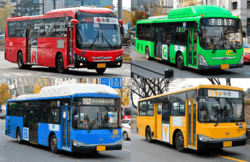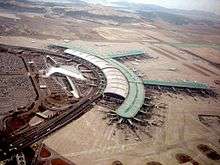Transportation in Seoul
Seoul's transportation boom dates back to the area of the Korean Empire, when the first streetcar lines were laid and a railroad linking Seoul and Incheon was completed. Today, as a result of the diversification of Seoul's transportation network, it has become a great transportation hub for Asia.
Airports
Main Articles: Incheon International Airport and Gimpo Airport
There are two airports that serve Seoul. Gimpo International Airport, formerly in Gimpo but annexed to Seoul in 1963, was the only airport for Seoul from its original construction during the Korean War. Multiple airports were built in and around Seoul immediately before, during, and after the war. The most famous was on Yeouido, which once served as the country's gateway to the world.
Upon opening in March 2001, Incheon International Airport on Yeongjong island in Incheon changed the role of Gimpo Airport significantly. Incheon is now responsible for almost all international flights. Following the opening of Incheon, Gimpo started only serving domestic flights, but has since started opening limited routes to major East Asian cities, such as Tokyo (Haneda Airport), Osaka (Kansai International Airport), Beijing (Beijing-Capital Airport), Shanghai (Shanghai–Hongqiao Airport), Taipei (Taipei–Songshan Airport).
Meanwhile, Incheon International Airport has become, along with Hong Kong and Singapore, a major transportation centre for East Asia. Following its opening in 2001, the airport opened a 3rd runway as well as a concourse extension in 2008, as well as Terminal 2 in 2018, with additional exansions currently under construction. Incheon International Airport has also frequently been voted amongst the best airports in the world, by Skytrax and Airports Council International[1].
Incheon and Gimpo are linked to Seoul and the rest of the country by highways, as well as urban rail service. The Incheon International Airport Railroad (or AREX, and styled as A'REX) station is located in the Transport Centre adjacent to the main terminal building provides urban rail services to Gimpo Airport and Seoul. In addition, the Incheon Airport Maglev also operates from the airport. As for Gimpo Airport, besides the AREX line, it is also connected to the Seoul Metropolitan Subway, as Gimpo Airport Station offers services on Line 5, Line 9 and the Gimpo Goldline.
Bus

There are four types of buses:[2]
Seoul has many big intercity/express bus terminals. These buses connect Seoul to cities all around Korea. Major bus terminals include
- Seoul Express Bus Terminal in Seocho-gu
- Central City in Seocho-gu
- Seoul Nambu Terminal, also in Seocho-gu
- Dongseoul Bus Terminal in Gwangjin-gu
- Sangbong Terminal in Jungnang-gu
Subway

Seoul has 21 subway lines that interlink every district of the city with one another and with the surrounding area. The majority of the population now uses the public transportation system due to its convenience and low cost. With more than 8 million passengers a day, Seoul has one of the busiest subway systems in the world.
Taxi

There are two tiers of taxis - Regular (일반 택시, Ilban taxi), and Deluxe (모범 택시, Mobeom taxi).
Regular taxis start at 3000 won for the first two kilometers and are metered at 100 won every 159 meters, which equates to about 695 won per kilometer. If the taxi is going less than 15 km per hour, an additional charge of 100 KRW per 37–39 seconds is added to the fare. A 20% surcharge is added between midnight and 4 am. These are typically white or silver in color but also can be seen in yellow
Deluxe taxis start at 4500 won for the first three kilometers and are metered at 200 won every 164 meters. Their name could also be translated as "Model Taxi" as their service should be an example of what a proper taxi is. Deluxe taxis do not have nightly surcharges.
Seoul city council announced Seoul Taxi will be repainted. They selected colour called Seoul Orange; look like similar orange or mud yellow. They are going to complete the painting until 2016.[3]
Train

Seoul is connected to every major city in South Korea by railroad. Seoul is also linked to most major Korean cities by the KTX bullet train which features a normal operation speed of more than 300 km/h, making commuting between cities extremely convenient for commuters and tourists. Major railroad stations include:
- Seoul Station, Jung-gu - Gyeongbu line (KTX/ITX-Saemaul/Mugunghwa-ho), Gyeongui line (Saemaul/Commuter)
- Yongsan Station, Yongsan-gu - Honam line (KTX/ITX-Saemaul/Mugunghwa), Jeolla/Janghang lines (Saemaul/Mugunghwa)
- Yeongdeungpo Station, Yeongdeungpo-gu - Gyeongbu/Honam/Janghang lines (ITX-Saemaul/Mugunghwa)
- Cheongnyangni Station, Dongdaemun-gu - Gyeongchun/Jungang/Yeongdong/Taebaek lines (Mugunghwa)
In addition, Suseo Station,in Gangnam District, is scheduled to open in late 2016, and offer KTX service on the newly built Suseo High Speed Railway.
References
- https://www.worldairportawards.com/worlds-top-10-airports-2020/#:~:text=Seoul%20Incheon-,Seoul%20Incheon,Best%20Transit%20Airport%20in%202020
- "Getting About:Bus". Infinitely yours, Seoul. Seoul Metropolitan Government. Archived from the original on 19 April 2013. Retrieved 6 October 2012.
- http://www.ytn.co.kr/_ln/0103_200910221815568307, YTN News 서울 고유택시 색깔 꽃담황토색

